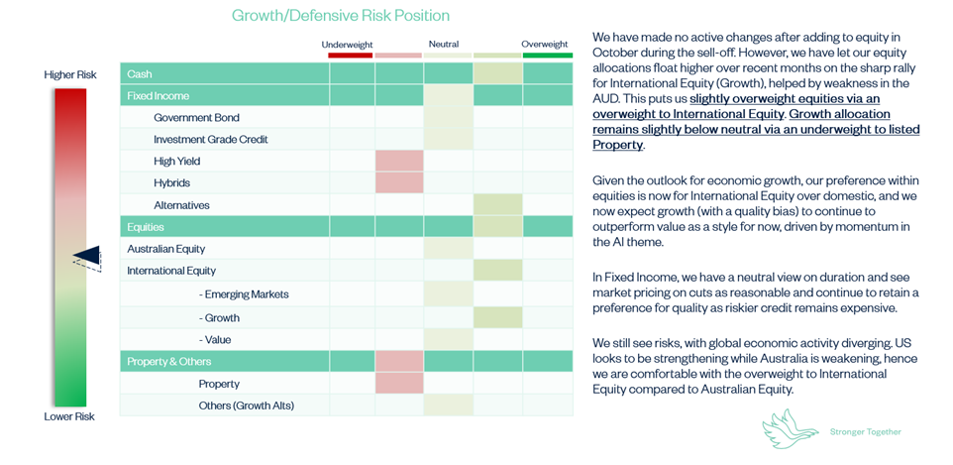Asset Class Performance and Outlook March 2024
Financial Advice
29-03-2024
Asset Class Performance and Outlook March 2024
SHARE
Australian Equities
We believe there is support for Australian Equities from institutions who are relatively underweight and good value versus the US equity market. A resurgent China that is now showing signs of stimulus gaining traction is positive for Australian equities. Most companies have managed their debt profiles by financing longer term in public markets where they can and keeping cash balances high in anticipation of a downturn. Now that much of that loss of economic momentum is behind us, market participants will be focused on the future upward business cycle. Earnings season in February was also supportive for this view with solid earnings results across most companies. The spread between larger companies and smaller and mid-sized companies is high, meaning that there is room for outperformance in small and mid cap stocks which perform favourably in upswings in economic growth.
International Equities
International equities, particularly the US larger cap stocks have performed well for the second quarter in a row following the sharp correction in October. The ‘Magnificent Seven’ continued to perform strongly, with Nvidia leveraging the AI thematic. There is value in US small and mid caps and in non-US equity markets. We are conscious that the valuations in large caps appear high, however as a business cycle recovery gets underway across most countries, there is room to grow into these valuations.
Fixed Income
Bond markets have rebalanced and been supported by a more positive economic outlook and investor support for government and corporate bond issues that are significantly higher than two years ago. Cash is available to deploy even though there has been some movement up in yields that incur losses in capital values, there is now sufficient total coupon income to offset capital losses with income. This means that bonds are more resilient to some volatility except for purely government bonds which have been more volatile in the last few quarters. We expect the short end of bond curves to reflect the expected immediate path of central bank policy cash rates which are pricing in declines in cash rates out by 2-5 years. The long end of the bond curve, 10 years plus, is priced on a combination of long term inflation expectations which have been reasonably anchored, and GDP growth. Long bonds are in the 4.1 – 4.3% area for Australia and the US, and flat to slightly rising out to 4.5% at 30 year maturity.
Tactical Asset Allocation
|
Factor |
Rationale |
|
Fundamental –Moderately Positive |
We see the economic fundamentals in Australia and overseas as improving off a low base. This is supported by forward looking indicators such as PMIs and OECD leading indices showing more signs of recovery from lows. In aggregate household and business cashflows seem to be providing more resilience despite high variation within the range of household and corporate financial situations. Policy fundamentals indicate major central banks are at the end of the rate hike cycle, with the main question on timing and number of interest rate cuts this year. The main case for modest cuts are the high real rates (that is the effective rate after inflation) which should be normalized from quite restrictive levels now that inflation now lower and trending further downwards. Traction of policy stimulus in China finally having an impact is very important for the rest of the world and Australia to support a broad global recovery. |
|
Valuation - Moderately Positive |
Valuations in equity markets are higher at the end of March, noting the strong recovery from lows in October. The Australian equity market has lagged the US market, mostly due to mega cap tech stocks performing well and better signs of inflation reduction and economic recovery. At the headline level, valuations are above historical averages but there is a wide dispersion of valuations with mid and small caps at cheaper valuations than very large stocks. |
|
Technical - Neutral |
Seasonality has played out much as we expected in the later months of 2023 and the first quarter of 2024, however we will be entering a seasonally weaker half year from May to October. Hence there may be more vulnerability to some correction. That said, we expect the four year US election cycle to provide another strong seasonal offset on balance, with some market volatility rising as the US election in November draws nearer. Market factors supportive are strong momentum and the potential for the rally in the larger cap names to broaden out into mid cap and smaller cap names as more signs of economic growth are signalled. On the downside, we see that good news from a resilient economy could be offset by a delay to the central bank rate cuts and market participants reassess the impact on equity and bond valuations. The lower volatility is more bullish overall as measures from equities, bonds, currency and gold volatility have declined. Positioning is very bullish amongst US retail investors while institutional investors are now modestly long equites having reversed their short positions from the fourth quarter last year. Hence, we see further “buy the dip” activity from institutions as they increase equity weights on a more optimistic economic outlook. |
|
Overall view for growth asset classes. |
Our net scorecard view is neutral for equities, riskier credit and growth asset classes leaning to slightly positive. We do see the economic downside scenarios as reduced based on improving forward looking indicators. Despite some potential for volatility and repricing of economic and policy rate scenarios, we see a growth recovery and a net positive for growth assets for 2024. |
Portfolio Positioning

This information is general in nature and is provided by Partners Wealth Group. It does not take into account the objectives, financial situation or needs of any particular person. You need to consider your financial situation and needs before making any decisions based on this information.